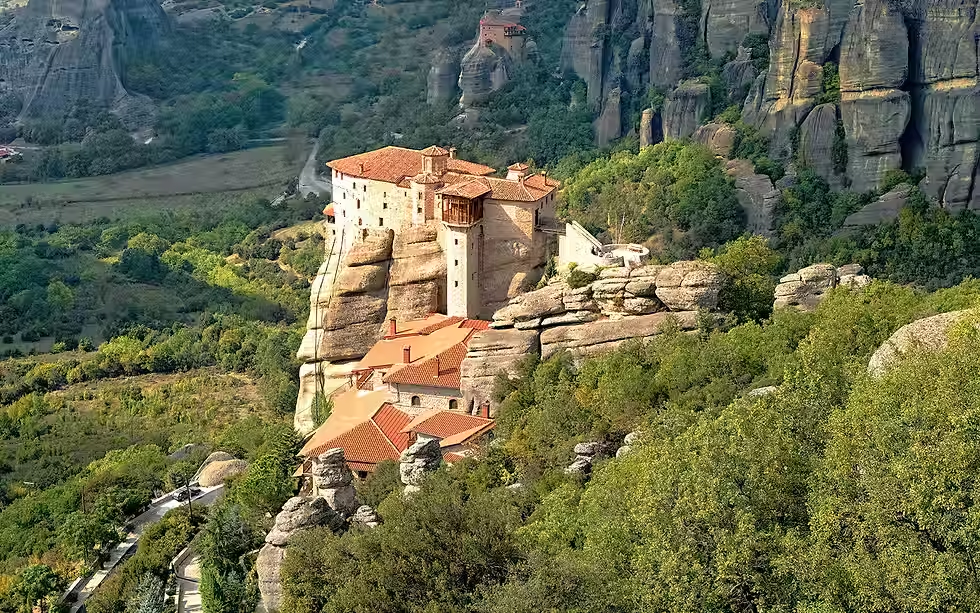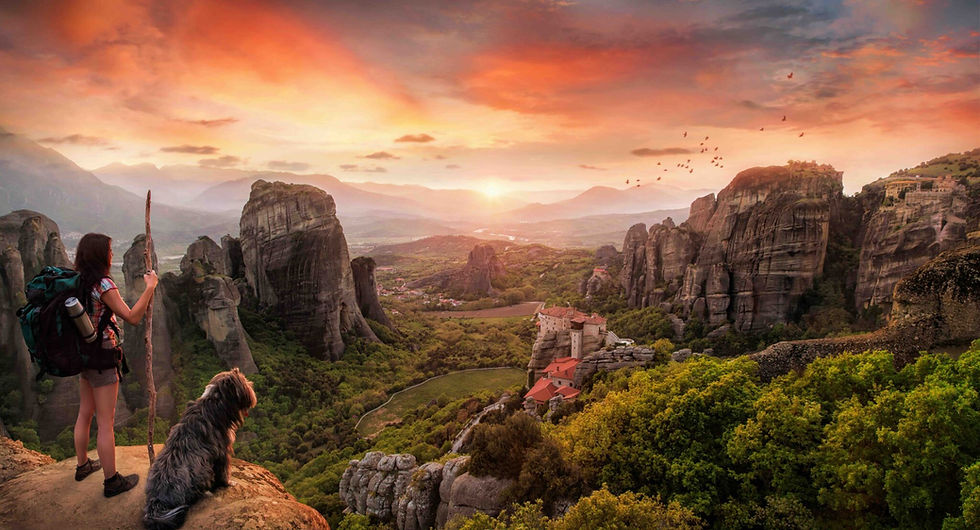Meteora: A Heavenly Fortress Suspended in Time
- Remo Bernardini

- Oct 8
- 4 min read
Updated: Oct 9

⏳ A Brief History of Meteora
The word "Meteora" literally means “suspended in the air”—and it fits like a glove. These colossal sandstone pillars, some as tall as 400 meters (1,300 feet), have been shaped over 60 million years by geological activity and erosion. But the magic really began in the 9th century, when hermit monks first climbed the rocks to live in solitude.
By the 14th century, as the Byzantine Empire was crumbling and the Ottoman Turks were rising, monks began building fortified monasteries atop these unreachable cliffs—for both spiritual elevation and physical protection.
At its peak, 24 monasteries dotted the rock forest. Today, only 6 remain active, each with its own unique legacy.

⛪ The 6 Active Monasteries of Meteora (Full History & Details)
Let’s go deeper into what makes each of these monasteries so special:
1. 🏰 Great Meteoron Monastery (Megalo Meteoro)

Founded: 14th century by Saint Athanasios the MeteoriteElevation: 615 meters above sea levelOpen: Usually closed on Tuesdays
This is the oldest, largest, and most important of the Meteora monasteries. Saint Athanasios established it around 1340, and it became the spiritual and administrative center of Meteora.
Inside, you’ll find:
A stunning katholikon (main church) with vibrant frescoes.
A museum showcasing manuscripts, weapons, and monk relics.
Ancient kitchens and cellars—preserved to show monastic life.
📜 Did you know? During Ottoman rule, this monastery played a key role in preserving Hellenic culture and Orthodox faith.
2. ⛅ Varlaam Monastery

Founded: 1517 by Theophanes and Nektarios ApsaradesElevation: Just below Great MeteoronOpen: Closed on Fridays
Varlaam is the second largest monastery, built on a site first occupied by a hermit monk named Varlaam in the 14th century. The two brothers who re-established it had to haul building materials up using ropes, baskets, and a winch—it took 22 years to get everything up the cliff!
Don’t miss:
The iconography inside the Church of All Saints.
A massive wooden barrel that held 12,000 liters of wine.
The peaceful gardens and panoramic terraces.
🎨 The frescoes inside are considered among the finest post-Byzantine examples.
3. 🌸 Rousanou Monastery (St. Barbara)

Founded: Mid-16th centuryConverted to a convent: 1980sOpen: Closed on Wednesdays
Rousanou stands on a lower rock and is easily accessible via a footbridge—making it ideal for those who want the experience without a strenuous climb. It’s run by nuns who maintain the grounds and host visitors with grace.
Highlights include:
Well-preserved 16th-century frescoes.
The peaceful, flower-filled courtyard.
Stunning interior iconostasis and murals.
👩🦳 The nuns here often offer small blessings or icons for sale, contributing to the monastery’s upkeep.
4. 🧘 Holy Trinity Monastery (Agia Triada)

Founded: 15th century by DometiosElevation: One of the highestOpen: Closed on Thursdays
This monastery is literally cinematic—featured in the James Bond film "For Your Eyes Only." But beyond Hollywood fame, Holy Trinity offers deep spiritual solitude and some of the best views in all of Meteora.
You’ll find:
A steep stairway carved into the rock—yes, it’s a workout!
17th-century frescoes inside its modest but sacred church.
A tiny chapel in a cave nearby.
🎥 Fun fact: Supplies were once hauled up using a basket and rope—today, there's a steep trail and steps.
5. 🌄 St. Stephen’s Monastery (Agios Stefanos)

Founded: 14th century Converted to a convent: 1961 Open: Closed on Mondays
This is the most accessible monastery—no stairs, just a bridge from the parking area. It was bombed during WWII but restored lovingly by the sisterhood who run it today.
What to see:
The new Church of Saint Charalambos, built over the ruins.
A beautiful museum with icons, manuscripts, and liturgical items.
Gorgeous gardens and wide terraces overlooking the valley.
🙏 Perfect for elderly travelers or those with mobility challenges.
6. 🕍 St. Nicholas Anapausas Monastery

Founded: Early 16th centuryOpen: Closed on Fridays
This small, single-level monastery might be compact—but don’t let size fool you. Inside is a masterpiece of art created by renowned Cretan painter Theophanis Strelitzas.
Check out:
A single-nave church packed with intricate frescoes.
A peaceful rooftop terrace with sweeping views.
A fascinating iconostasis and ancient relics.
🎨 Art lovers, this one’s a must-see.
🧠 Meteora’s Cultural & Religious Significance

Meteora is a UNESCO World Heritage Site—for both natural and cultural reasons. Spiritually, it’s one of the most sacred places in Eastern Orthodoxy, second only to Mount Athos.
It served as a spiritual haven during invasions and wars.
Monks here preserved Greek manuscripts, traditions, and faith through centuries of conflict.
Even today, these monasteries are working religious centers—not just museums.
🙌 Remember: Be respectful. No loud voices, selfies in sacred areas, or inappropriate clothing.
🔭 Bonus: Off-the-Beaten-Path Sights in Meteora

If you’re spending more than a day or two, check these out:
Theopetra Cave – Home to the oldest known man-made structure in the world!
Natural Rock Formations – Names like "Devil’s Tower" and "Needle of Rousanou" will make your camera happy.
Old Hermit Caves – Some are visible from trails but rarely visited.
📝 Suggested Itinerary for Meteora
Day 1:
Morning: Train to Kalambaka
Afternoon: Visit Rousanou & St. Nicholas
Sunset: Viewpoint near Psaropetra Rock
Day 2:
Morning hike to Varlaam & Great Meteoron
Afternoon: Visit Holy Trinity & St. Stephen’s
Evening: Dinner in Kastraki
Day 3 (optional):
Explore Theopetra Cave or hike a different trail
Relax in Kalambaka, shop for souvenirs
🧳 Packing Checklist (Expanded)
🎒 Small daypack
📷 Camera or phone with extra storage
🙏 Scarf or shawl for monastery visits
💧 Refillable water bottle
🧴 Sunscreen & sunglasses
🗺️ Offline maps (signal can be spotty)
Why Meteora Should Be on Your Travel List

Meteora isn’t just “another pretty place.” It’s a deep, emotional experience wrapped in ancient stones, silent prayers, and sky-high views that’ll leave you awestruck.
Whether you come for the adventure, the spirituality, or simply the peace and quiet—you’ll leave with something more.
🙋 FAQs
Q: Can you stay inside a monastery overnight?
A: No, tourists cannot sleep in the monasteries—they're active religious sites. But nearby guesthouses offer cozy stays.
Q: Are drones allowed?
A: Nope! Meteora is a protected site, and drones are strictly prohibited without special permission.
Q: Are guided tours worth it?
A: If you’re into history, yes. A guide can explain religious symbolism, architecture, and hidden stories you’d otherwise miss.




Comments